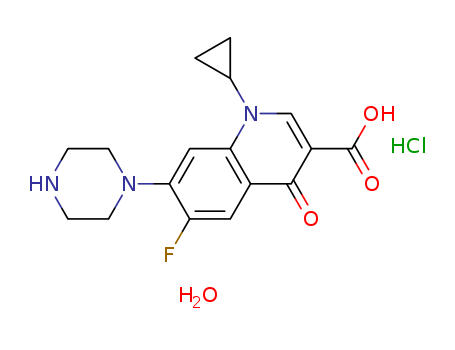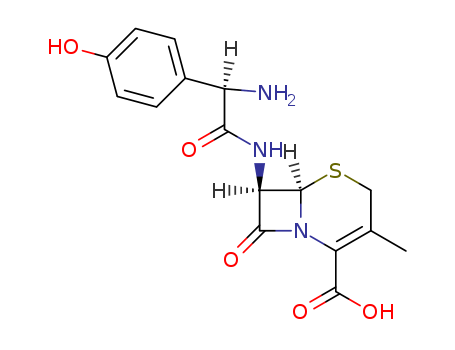
86393-32-0
- Product Name:Ciprofloxacin Hydrochloride
- Molecular Formula:C17H18FN3O3.ClH.H2O
- Purity:99%
- Molecular Weight:385.823
Product Details;
CasNo: 86393-32-0
Molecular Formula: C17H18FN3O3.ClH.H2O
Appearance: White or yellowish crystalline powder
Hot Sale Buy High Quality Ciprofloxacin Hydrochloride 86393-32-0 Fast Delivery
- Molecular Formula:C17H18FN3O3.ClH.H2O
- Molecular Weight:385.823
- Appearance/Colour:White or yellowish crystalline powder
- Vapor Pressure:2.24E-14mmHg at 25°C
- Melting Point:318-320 °C
- Boiling Point:581.8 °C at 760 mmHg
- Flash Point:305.6 °C
- PSA:83.80000
- LogP:2.71480
Ciprofloxacin hydrochloride hydrate(Cas 86393-32-0) Usage
|
Chemical Properties |
Pale yellow, crystalline, slightly hygroscopic powder. |
|
Uses |
Ciprofloxacin hydrochloride has been suggested as a treatment for a wide range of infections caused by susceptible organisms including infections of urinary, respiratory, and gastrointestinal tracts, gonorrhoea and septicaemia. Nalidixic acid analogue. |
|
Application |
Ciprofloxacin hydrochloride hydrate is a broad-spectrum antibiotic that inhibits bacterial DNA gyrase and blocks DNA synthesis and replication, resulting in bacterial death. It has strong antibacterial activity against Escherichia coli, Klebsiella and other Enterobacteriaceae; the antibacterial activity against Pseudomonas aeruginosa, Staphylococcus aureus and Streptococcus pneumoniae is better than norfloxacin and pefloxacin. |
|
Definition |
ChEBI: The monohydrate form of ciprofloxacin monohydrochloride. |
|
Brand name |
Ciloxan (Alcon); Cipro (Bayer); Proquin (Esprit). |
|
General Description |
Ciprofloxacin HCl is a fluoroquinolone antibiotic agent, which shows a broad spectrum of antibacterial activity against gram positive and gram negative bacteria. |
|
in vitro |
Ciprofloxacin (hydrochloride monohydrate) is a fluoroquinolone antibiotic, exhibiting potent antibacterial activity. Ciprofloxacin (hydrochloride monohydrate) (CIP) shows potent activity against Y. pestis with MIC 90 of 0.03 μg/mL. |
|
in vivo |
Ciprofloxacin (hydrochloride monohydrate) (1 mg/L) induces glutathione-S-transferase (GST) activity, in contrast with inhibited GST and Catalase (CAT) of larvae exposed to enrofloxacin. Ciprofloxacin (hydrochloride monohydrate) (≥10 μg/L) is ecotoxic for development, growth, detoxifying, and oxidative stress enzymes in anuran amphibian larvae. In a murine model of pneumonic plague, Ciprofloxacin (hydrochloride monohydrate) (30 mg/kg, i.p.) results in a drug exposure which is similar to the drug exposure observed in human following a 500 mg dose of oral Ciprofloxacin (hydrochloride monohydrate). Intraperitoneal Ciprofloxacin (hydrochloride monohydrate) reduces the lung bacterial load compare to controls treated with intraperitoneal PBS. |
InChI:InChI=1/C17H18FN3O3.ClH.H2O/c18-13-7-11-14(8-15(13)20-5-3-19-4-6-20)21(10-1-2-10)9-12(16(11)22)17(23)24;;/h7-10,19H,1-6H2,(H,23,24);1H;1H2
86393-32-0 Downstream products
-
93107-08-5

ciprofloxacin hydrochloride
Relevant Products
-
Citalopram hydrochloride
CAS:85118-27-0
-
Cefadroxil
CAS:50370-12-2
-
Manufacturer Rosuvastatin methyl ester
CAS:147118-40-9








